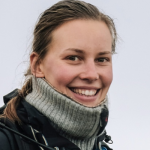Research Activity 1 – Mechanisms giving rise to climate predictability
Mechanistic understanding is a prerequisite for identifying predictable relations in observations and models. RA1 aims to identify and model the interactions within and among climate system components that give rise to predictability. We will also consider external factors (greenhouse gases, volcanic eruptions, aerosols, solar forcing) that can add predictive skill. RA1’s basic approach is to identify the relevant physical mechanisms in observations and reanalysis (RA2), test them in model experiments, and improve their representation in NorCPM.
T1.1 Predictability here is hypothesized to be rooted in ocean inertia, and more specifically in poleward ocean heat transport. We will investigate the mechanisms and time scales involved in the propagation of ocean heat anomalies along the Gulf Stream’s extension toward the Arctic, how the anomalies interact with the atmosphere, their impact on sea ice predictability, and eventual influence on continental climate variability.
T1.2 It is unclear to what degree air-ice-ocean coupling can explain the observed climate variability. We will study large-scale air-ice-ocean coupling; interaction over sharp SST and sea ice fronts, and on synoptic scales; and identify coupled modes of climate variability and the impact of external forcing.
T1.3 A large component of predictability in the Atlantic-Arctic sector might arise from teleconnections from the tropics, the North Pacific, sea ice, snow cover and land surface conditions. Advanced atmospheric diagnostics will be used to study the importance and mechanisms of the various teleconnections.
T1.4 Models appear to underestimate predictable dynamics and suffer from large model biases35. Motivated by findings of T1.1-T1.3 (and other RA), improvements will be implemented into NorCPM to alleviate such problems. A key first step will be to develop a stratosphere-resolving version of NorCPM25. We will also consider model resolution, and implement new parameterisations.
Publications
Årthun, M., Asbjørnsen, H., Chafik, L., Johnson, H.L., Våge, K. 2023: Future strengthening of the Nordic Seas overturning circulation. Nat Commun. https://www.nature.com/articles/s41467-023-37846-6 Summary: The overturning circulation in the Nordic Seas involves the transformation of warm Atlantic waters into cold, dense overflows. These overflow waters return to the North Atlantic and form the headwaters to the deep limb of the Atlantic meridional overturning circulation (AMOC). The Nordic Seas are thus a key component of the AMOC. However, little is known about the response of the overturning circulation in the Nordic Seas to future climate change. Here we show using global climate models that, in contrast to the North Atlantic, the simulated density-space overturning circulation in the Nordic Seas increases throughout most of the 21st century as a result of enhanced horizontal circulation and a strengthened zonal density gradient. The increased Nordic Seas overturning is furthermore manifested in the overturning circulation in the eastern subpolar North Atlantic. A strengthened Nordic Seas overturning circulation could therefore be a stabilizing factor in the future AMOC. Link to publication. You are most welcome to contact us or the corresponding author(s) directly, if you have questions.
Rieke, O., Årthun, M., Dörr, J.S. 2023: Rapid sea ice changes in the future Barents Sea. The Cryosphere. https://doi.org/10.5194/tc-17-1445-2023 Summary: Observed and future winter Arctic sea ice loss is strongest in the Barents Sea. However, the anthropogenic signal of the sea ice decline is superimposed by pronounced internal variability that represents a large source of uncertainty in future climate projections. A notable manifestation of internal variability is rapid ice change events (RICEs) that greatly exceed the anthropogenic trend. These RICEs are associated with large displacements of the sea ice edge which could potentially have both local and remote impacts on the climate system. In this study we present the first investigation of the frequency and drivers of RICEs in the future Barents Sea, using multi-member ensemble simulations from CMIP5 and CMIP6. A majority of RICEs are triggered by trends in ocean heat transport or surface heat fluxes. Ice loss events are associated with increasing trends in ocean heat transport and decreasing trends in surface heat loss. RICEs are a common feature of the future Barents Sea until the region becomes close to ice-free. As their evolution over time is closely tied to the average sea ice conditions, rapid ice changes in the Barents Sea may serve as a precursor for future changes in adjacent seas. Link to publication. You are most welcome to contact us or the corresponding author(s) directly, if you have questions.
Crespo, L.R., Prigent, A., Keenlyside, N., Koseki, S., Svendsen, L., Richter, I., Sánchez-Gómez, E. 2022: Weakening of the Atlantic Niño variability under global warming. Nat. Clim. Chang. https://doi.org/10.1038/s41558-022-01453-y Summary: The Atlantic Niño is one of the most important patterns of interannual tropical climate variability, but how climate change will influence this pattern is not well known due to large climate model biases. Here we show that state-of-the-art climate models robustly predict a weakening of Atlantic Niños in response to global warming, mainly due to a decoupling of subsurface and surface temperature variations as the upper equatorial Atlantic Ocean warms. This weakening is predicted by most (>80%) models in the Coupled Model Intercomparison Project Phases 5 and 6 under the highest emission scenarios. Our results indicate a reduction in variability by the end of the century by 14%, and as much as 24–48% when accounting for model errors using a simple emergent constraint analysis. Such a weakening of Atlantic Niño variability will potentially impact climate conditions and the skill of seasonal predictions in many regions. Link to publication. You are most welcome to contact us or the corresponding author(s) directly, if you have questions.
Omrani, NE., Keenlyside, N., Matthes, K., Boljka, L., Zanchettin, D., Jungclaus, JH., Lubis, SW. 2022: Coupled stratosphere-troposphere-Atlantic multidecadal oscillation and its importance for near-future climate projection. npj Clim Atmos Sci. https://doi.org/10.1038/s41612-022-00275-1 Summary: Northern Hemisphere (NH) climate has experienced various coherent wintertime multidecadal climate trends in stratosphere, troposphere, ocean, and cryosphere. However, the overall mechanistic framework linking these trends is not well established. Here we show, using long-term transient forced coupled climate simulation, that large parts of the coherent NH-multidecadal changes can be understood within a damped coupled stratosphere/troposphere/ocean-oscillation framework. Wave-induced downward propagating positive stratosphere/troposphere-coupled Northern Annular Mode (NAM) and associated stratospheric cooling initiate delayed thermohaline strengthening of Atlantic overturning circulation and extratropical Atlantic-gyres. These increase the poleward oceanic heat transport leading to Arctic sea-ice melting, Arctic warming amplification, and large-scale Atlantic warming, which in turn initiates wave-induced downward propagating negative NAM and stratospheric warming and therefore reverse the oscillation phase. This coupled variability improves the performance of statistical models, which project further weakening of North Atlantic Oscillation, North Atlantic cooling and hiatus in wintertime North Atlantic-Arctic sea-ice and global surface temperature just like the 1950s–1970s. Link to publication. You are most welcome to contact us or the corresponding author(s) directly, if you have questions.
Zaplotnik, Ž., M. Pikovnik, L. Boljka, L. 2022: Recent Hadley Circulation Strengthening: A Trend or Multidecadal Variability? J Clim. https://doi.org/10.1175/JCLI-D-21-0204.1 Summary: This study explores the possible drivers of the recent Hadley circulation strengthening in the modern reanalyses. Predominantly, two recent generations of reanalyses provided by the European Centre for Medium-Range Weather Forecasts are used: the fifth-generation atmospheric reanalysis (ERA5) and the interim reanalysis (ERA-Interim). Some results are also evaluated against other long-term reanalyses. To assess the origins of the Hadley cell (HC) strength variability, we employ the Kuo–Eliassen (KE) equation. ERA5 shows that both HCs were strengthening prior to the 2000s, but they have been weakening or remained steady afterward. Most of the long-term variability in the strength of the HCs is explained by the meridional gradient of diabatic (latent) heating, which is related to precipitation gradients. However, the strengthening of both HCs in ERA5 is larger than the strengthening expected from the observed zonal-mean precipitation gradient [estimated from the Global Precipitation Climatology Project (GPCP)]. This suggests that the HC strength trends in the recent decades in ERA5 can be explained partly as an artifact of the misrepresentation of latent heating and partly through (physical) long-term variability. To show that the latter is true, we analyze ERA5 preliminary data for the 1950–78 period, other long-term (e.g., twentieth century) reanalyses, and sea surface temperature observational data. This reveals that the changes in the HC strength can be a consequence of the Atlantic multidecadal oscillation (AMO) and related diabatic and frictional processes, which in turn drive the global HC variability. This work has implications for further understanding of the long-term variability of the Hadley circulation. Link to publication. You are most welcome to contact us or the corresponding author(s) directly, if you have questions.
Pikovnik, M., Zaplotnik, Ž., Boljka, L., Žagar, N. 2022: Metrics of the Hadley circulation strength and associated circulation trends. Weather Clim Dynam. https://doi.org/10.5194/wcd-3-625-2022 Summary: This study compares trends in the Hadley cell (HC) strength using different metrics applied to the ECMWF ERA5 and ERA-Interim reanalyses for the period 1979–2018. The HC strength is commonly evaluated by metrics derived from the mass-weighted zonal-mean stream function in isobaric coordinates. Other metrics include the upper tropospheric velocity potential, the vertical velocity in the mid-troposphere, and the water vapour transport in the lower troposphere. Seven known metrics of HC strength are complemented here by a metric of the spatially averaged HC strength, obtained by averaging the stream function in the latitude–pressure (φ–p) plane, and by the total energy of zonal-mean unbalanced circulation in the normal-mode function decomposition. It is shown that metrics, which rely on single-point values in the φ–p plane, produce unreliable 40-year trends in both the northern and southern HCs, especially in ERA-Interim; magnitudes and even the signs of the trends depend on the choice of the HC strength metric. The two new metrics alleviate the vertical and meridional inhomogeneities of the trends in HC strength. The unbalanced energy metric suggests a positive HC trend in both reanalyses, whereas the metric based on averaging the stream function finds a significant positive trend only in ERA5. Link to publication. You are most welcome to contact us or the corresponding author(s) directly, if you have questions.
Efstathiou, E., Eldevik, T., Årthun, M., Lind, S. 2022: Spatial patterns, mechanisms and predictability of Barents Sea ice change. J Clim. https://doi.org/10.1175/JCLI-D-21-0044.1 . Summary: Recent Arctic winter sea ice loss has been most pronounced in the Barents Sea. Here we explore the spatial structure of Barents Sea ice change as observed over the last 40 years. The dominant mode of winter sea ice concentration interannual variability corresponds to areal change (explains 43% of spatial variance) and has a center of action in the northeastern Barents Sea where the temperate Atlantic inflow meets the wintertime sea-ice. Sea ice area import and northerly wind also contribute to this “areal-change mode”; the area increases with more ice import and stronger winds from the north. The remaining 57% variance in sea ice, individually and combined, redistributes the sea ice without changing the total area. The two leading redistribution modes are a dipole of increase in sea ice concentration south of Svalbard with decrease southwest of Novaya Zemlya, and a tripole of increase in the central Barents Sea with decrease east of Svalbard and in the southeastern Barents Sea. Redistribution is mainly contributed by anomalous wind and sea ice area import. Basic predictability, i.e., the lagged response to observed drivers, is predominantly associated with the areal-change mode as influenced by temperature of the Atlantic inflow and sea ice import from the Arctic. Link to publication. You are most welcome to contact us or the corresponding author(s) directly, if you have questions.
Cheung, HN., Keenlyside, N., Koenigk, T., Yang, S., Tian, T., Xu, Z., Gao, Y., Ogawa, F., Omrani, N.-E., Qiao, S., Zhou, W. 2022: Assessing the influence of sea surface temperature and arctic sea ice cover on the uncertainty in the boreal winter future climate projections. Clim. Dyn. https://doi.org/10.1007/s00382-022-06136-0 Summary: We investigate the uncertainty (i.e., inter-model spread) in future projections of the boreal winter climate, based on the forced response of ten models from the CMIP5 following the RCP8.5 scenario. The uncertainty in the forced response of sea level pressure (SLP) is large in the North Pacific, the North Atlantic, and the Arctic. A major part of these uncertainties (31%) is marked by a pattern with a center in the northeastern Pacific and a dipole over the northeastern Atlantic that we label as the Pacific–Atlantic SLP uncertainty pattern (PA∆SLP). The PA∆SLP is associated with distinct global sea surface temperature (SST) and Arctic sea ice cover (SIC) perturbation patterns. To better understand the nature of the PA∆SLP, these SST and SIC perturbation patterns are prescribed in experiments with two atmospheric models (AGCMs): CAM4 and IFS. The AGCM responses suggest that the SST uncertainty contributes to the North Pacific SLP uncertainty in CMIP5 models, through tropical–midlatitude interactions and a forced Rossby wavetrain. The North Atlantic SLP uncertainty in CMIP5 models is better explained by the combined effect of SST and SIC uncertainties, partly related to a Rossby wavetrain from the Pacific and air-sea interaction over the North Atlantic. Major discrepancies between the CMIP5 and AGCM forced responses over northern high-latitudes and continental regions are indicative of uncertainties arising from the AGCMs. We analyze the possible dynamic mechanisms of these responses, and discuss the limitations of this work. Link to publication. You are most welcome to contact us or the corresponding author(s) directly, if you have questions.
Hordoir, R., Skagseth, Ø., Ingvaldsen, R.B., Sandø, A.B., Löptien, U., Dietze, H., Gierisch, A.M.U., Assmann K.A., Lundesgaard,Ø., Lind, S. 2022: Changes in Arctic Stratification and Mixed Layer Depth Cycle: A Modeling Analysis. JGR Oceans. https://doi.org/10.1029/2021JC017270 Summary: We analyzed the results of an ocean model simulation for the Arctic and North Atlantic oceans for the period 1970–2019. Our model is in line with the recent observed changes in the Arctic Ocean and allows, in contrast to the rather sparse observations, a detailed assessment of stratification changes. These changes will affect the Arctic ecosystem and are also believed to affect the large scale ocean circulation. We show that major changes in upper ocean conditions are caused by changes in the fresh water supply by sea ice and varying effect of the wind on regions that are now becoming ice-free. We also study the effect of changes in river runoff into the Arctic Ocean. Our study shows that an increase in river runoff can change the coastal circulation and results, paradoxically, in regions of higher salinity. These results point to the importance of modeling tools when it comes to a better understanding of ocean processes in a changing climate. Link to publication. You are most welcome to contact us or the corresponding author(s) directly, if you have questions.
Dörr, J., Årthun, M., Eldevik, T., Madonna, E. 2021: Mechanisms of regional winter sea-ice variability in a warming Arctic. Journal of Climate. https://doi.org/10.1175/JCLI-D-21-0149.1 . Summary: The Arctic winter sea ice cover is in retreat overlaid by large internal variability. Changes to sea ice are driven by exchange of heat, momentum, and freshwater within and between the ocean and the atmosphere. Using a combination of observations and output from the Community Earth System Model Large Ensemble, we analyze and contrast present and future drivers of the regional winter sea ice cover. Consistent with observations and previous studies, we find that for the recent decades ocean heat transport though the Barents Sea and Bering Strait is a major source of sea ice variability in the Atlantic and Pacific sectors of the Arctic, respectively. Future projections show a gradually expanding footprint of Pacific and Atlantic inflows highlighting the importance of future Atlantification and Pacification of the Arctic Ocean. While the dominant hemispheric modes of winter atmospheric circulation are only weakly connected to the sea ice, we find distinct local atmospheric circulation patterns associated with present and future regional sea ice variability in the Atlantic and Pacific sectors, consistent with heat and moisture transport from lower latitudes. Even if the total freshwater input from rivers is projected to increase substantially, its influence on simulated sea ice is small in the context of internal variability. Link to publication. You are most welcome to contact us or the corresponding author(s) directly, if you have questions.
Group members

Role: Data manager and software engineer (2021-present)
E-mail: tarkan.bilge@uib.no

Role: PhD student affiliated to RA1 (2019-present)
E-mail: Evangelia.Efstathiou@uib.no

Role: PhD student affiliated to RA1 (2021-present)
E-mail: luca.famoosspaolini@unive.it

Role: Masters' assignment in RA1&RA3 (2021)
E-mail: mahaut.vareilles@uib.no

Role: PhD student in RA1 and RA3 (2019-present)
E-mail: Leilane.Passos@uib.no

Role: Masters student affilitated to RA1 (2021-2022)
E-mail: mahaut.vareilles@uib.no

Role: Postdoc affiliated to RA1 (2019-present)
E-mail: Francine.Schevenhoven@uib.no

Role: PhD student affiliated to RA1 (2021-present)
E-mail: Johanne.Skrefsrud@uib.no















